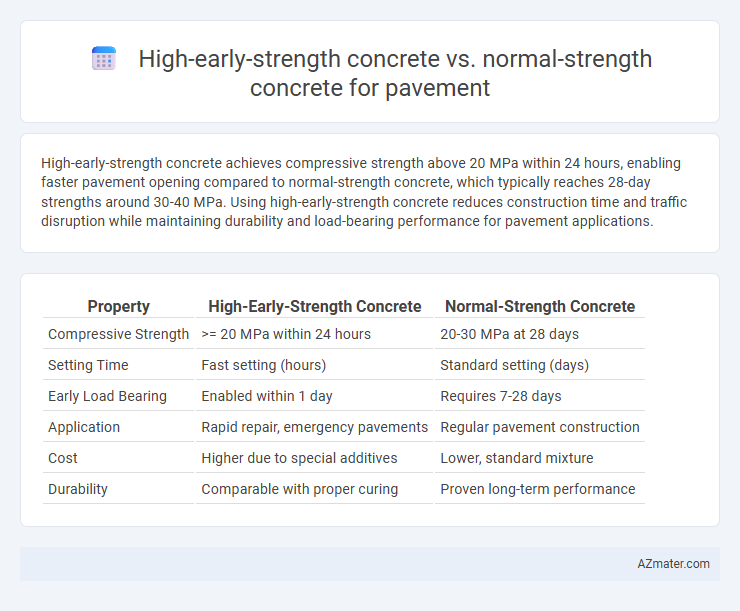High-early-strength concrete achieves compressive strength above 20 MPa within 24 hours, enabling faster pavement opening compared to normal-strength concrete, which typically reaches 28-day strengths around 30-40 MPa. Using high-early-strength concrete reduces construction time and traffic disruption while maintaining durability and load-bearing performance for pavement applications.
Table of Comparison
| Property | High-Early-Strength Concrete | Normal-Strength Concrete |
|---|---|---|
| Compressive Strength | >= 20 MPa within 24 hours | 20-30 MPa at 28 days |
| Setting Time | Fast setting (hours) | Standard setting (days) |
| Early Load Bearing | Enabled within 1 day | Requires 7-28 days |
| Application | Rapid repair, emergency pavements | Regular pavement construction |
| Cost | Higher due to special additives | Lower, standard mixture |
| Durability | Comparable with proper curing | Proven long-term performance |
Introduction to Concrete Types for Pavement
High-early-strength concrete achieves compressive strength of 20 MPa or more within 24 hours, enabling faster construction and early traffic loading for pavement applications. Normal-strength concrete typically develops strength over 28 days, reaching compressive strengths between 20 to 40 MPa, suitable for standard pavement durability and load requirements. The choice between high-early-strength and normal-strength concrete impacts project timelines, structural performance, and cost, influencing pavement design and maintenance strategies.
Key Characteristics of High-Early-Strength Concrete
High-early-strength concrete achieves compressive strengths above 6 MPa within 24 hours, significantly reducing curing time compared to normal-strength concrete which typically gains strength over 28 days. This rapid strength development relies on optimized mix designs with higher cement content, supplementary cementitious materials like silica fume, and chemical accelerators. Enhanced durability, early traffic serviceability, and reduced construction time are key benefits making it ideal for fast-track pavement projects requiring quick load-bearing capacity.
Properties of Normal-Strength Concrete
Normal-strength concrete for pavement typically exhibits a compressive strength ranging from 20 to 40 MPa, ensuring adequate load-bearing capacity for standard traffic conditions. It offers moderate setting times and durability, with lower heat of hydration compared to high-early-strength concrete, reducing the risk of thermal cracking in large slabs. This type of concrete provides sufficient workability and cost-effectiveness for long-term pavement applications where rapid opening to traffic is not critical.
Pavement Performance: Strength and Durability Comparison
High-early-strength concrete achieves compressive strengths above 6,000 psi within 24 hours, enabling rapid pavement load-carrying capacity compared to normal-strength concrete, which typically reaches 3,000-4,000 psi at 28 days. Enhanced early strength significantly reduces construction time and traffic disruption while providing superior resistance to freeze-thaw cycles, scaling, and abrasion. Despite higher initial material costs, high-early-strength concrete offers improved long-term pavement durability and reduced maintenance frequency.
Setting Time and Construction Speed
High-early-strength concrete achieves compressive strength significantly faster than normal-strength concrete, typically reaching 70% to 90% of its design strength within 24 hours compared to 7 to 28 days, which accelerates setting time and allows for quicker pavement opening to traffic. This rapid strength development enhances construction speed by reducing downtime between pouring and load application, critical for minimizing road closure durations in infrastructure projects. High-early-strength mixes often incorporate Type III cement or admixtures to optimize hydration rates, making them ideal for fast-track pavement construction requiring early load-bearing capacity.
Cost Comparison: Material and Labor
High-early-strength concrete for pavement generally incurs higher material costs due to specialized cement and admixtures accelerating curing times. Labor expenses tend to be lower because the faster setting reduces on-site time and equipment rental, enhancing overall project efficiency. In contrast, normal-strength concrete requires less expensive materials but often increases labor costs, extending construction duration and potentially impacting traffic management expenses.
Environmental Impact and Sustainability
High-early-strength concrete reduces construction time, lowering carbon emissions by minimizing equipment use and site activity duration, which enhances sustainability in pavement projects. Normal-strength concrete typically requires longer curing and compaction periods, leading to increased energy consumption and higher environmental impact. Choosing high-early-strength concrete supports eco-friendly infrastructure by decreasing greenhouse gas emissions associated with prolonged construction processes.
Suitability for Various Pavement Applications
High-early-strength concrete achieves compressive strength faster than normal-strength concrete, making it ideal for rapid construction and early traffic loading in pavement applications such as airport runways and emergency repairs. Normal-strength concrete, with slower curing, suits long-term structural pavements like highways and residential streets that prioritize durability and cost efficiency over quick turnaround times. Choosing between these concrete types depends on project timelines, load-bearing requirements, and maintenance schedules for optimal pavement performance.
Maintenance and Lifecycle Considerations
High-early-strength concrete cures rapidly, enabling quicker pavement opening and reducing initial maintenance downtime compared to normal-strength concrete, which requires longer curing times. The accelerated strength gain minimizes early-age cracking and surface defects, extending pavement lifespan and lowering lifecycle maintenance costs. Although high-early-strength concrete typically has higher material expenses, its enhanced durability and reduced repair frequency offer long-term economic benefits in pavement applications.
Conclusion: Selecting the Right Concrete for Pavement
High-early-strength concrete accelerates construction schedules and reduces traffic disruption by achieving rapid load-bearing capacity, making it ideal for projects with tight timelines. Normal-strength concrete offers enhanced durability and cost-effectiveness for long-term pavement performance under standard traffic conditions. Choosing the appropriate concrete depends on project requirements, balancing early strength needs with durability and budget considerations.

Infographic: High-early-strength concrete vs Normal-strength concrete for Pavement
 azmater.com
azmater.com